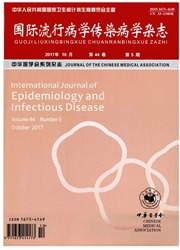

 中文摘要:
中文摘要:
目的研究六价铬暴露对电镀作业工人外周血DNA损伤及hOGGl基因表达的影响。方法选取50名电镀作业工人为暴露组,40名后续工种及行政管理人员为对照组,检测两组血铬、DNA损伤、血浆GSH含量及hOGG1基因表达水平,并分析各指标之间的相关性。结果暴露组血铬和DNA损伤(%Tail DNA)的中位数(四分位数)分别为1.39(0.15~46.63)μg/L和4.82(1.74~23.18),均明显高于对照组(P〈0.01);而血浆GSH平均含量(7.41±2.37)nmoL/mL和hOGGl基因表达水平均值(0.74±0.40)倍均明显低于对照组(P〈0.01);各指标之间相关性分析未发现有统计学意义(P〉0.05)。结论职业接触六价铬可致工人外周血DNA榻伤增加.可能与m浆GSH含量及hOGG1基因表汰水平降低有关。
 英文摘要:
英文摘要:
Objective To study the effects of hexavalent chromium exposure on DNA damage and hOGG1 gene expression among electroplating workers. Methods Fifty electroplating workers and forty workers who engaged in operations after electroplating and administrative personnel were selected as exposed group and control group, respectively. Blood Cr, DNA damage, plasma GSH, and hOGG1 gene expression were detected in biological samples, and the correlation between each indexes were analyzed. Results The mean blood Cr and DNA damage in exposed group were 5.54±9.32 μg/L and 6.91 ± 5.91, respectively, which were both higher than that of control group( P 〈 0. 01 ). The mean content of plasma GSH and hOGG1 gene expression in exposed group were 7.41 ±2. 37 nmol/ml and 0. 74±0. 40, respectively, which were both significantly lower than that of control group ( P 〈 0. 01 ). However, no correlation was found between each index. Conclusion Occupational exposure of hexavalent chromium could cause DNA damage in electroplating workers, and it may be related with the reduction of plasma GSH and hOGG1 gene expression.
 同期刊论文项目
同期刊论文项目
 同项目期刊论文
同项目期刊论文
 期刊信息
期刊信息
